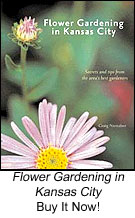Visit
Our Website
Previous
Issues
Buyer's
Guide
Tell A
Friend
Donations
Send
A Postcard!
Bookstore
Magazines
Gardening
Catalogs
Site
Search
Contact
Us
Submit
A Tip
Feature
Articles
Rose
Tips
What's
Hot...
Nuisance
of the Week
Turf
Tips...
Winter
Wisdom
Gardener's
Glossary
Books
We Love
Great
Products
Web
Resources
Event Calendar
Local
Sponsors
Subscribe
Tell
A Friend
Privacy
Pledge


|
 |
September 22, 2004 |

|
Falling For Fun...
Fall has arrived! I am excited. There are so many great
things that happen this time of year. The color of the landscape
changes from bright showy colors to warm, deeper hues. The smell
in the air changes from a hot, humid
"ugh" to cool,
crisp and wonderful. Surrounding communities throw fall festivals
so that neighbors can come together to enjoy the change
of the season. Many families will share in special traditions
such as apple picking, pumpkin hunting,
and jack-o-lantern carving. A new
season has arrived so enjoy, my
friends.
Kevin and I
have a lot work ahead of us. We typically plant close to 500
bulbs in the fall. Daffodils, tulips and crocus are some of our
favorites. This is not an easy task. I remember last year when we
were planting all of those bulbs. I kept looking at all of those
bags and saying to myself "Where am I going to put all of these?"
We seem to have managed and planted all but a few. The leftovers
were stuck in the garage for later planting. I found them this
spring and had to toss them. I guess that's
one way to avoid
planting
them.
Randy's Lakeview Nursery & Bulk Supercenter is having
their Oktoberfest Saturday October 2nd. I will be there from
12:00 PM to 3:00 PM so join me in the festivities. There will be
free hot dogs, soda, popcorn, face painting, balloons and a train
ride through the nursery for children. Now that sounds like a
great time! Hope to see you there.
~
Shelly
Totally Tulips (Part
III)...
If you enjoy the thought of continuously blooming tulips in
your spring garden you will need to round out the early and
middle bloomers (discussed in the previous two issues) with some
of these later blooming varieties:
-
Single Late Tulips incorporate the former Darwin, cottage,
and breeder tulips. Along with the Darwin hybrid tulips, they
are some of the tallest tulips. Flowers are borne on stems up
to 30 inches tall and available in a wide range of colors.
-
Double Late Tulips are often referred to as peony-flowered
tulips. The many-petaled flowers are borne on 12 to 20 inch
stems. Plant double late tulips in protected locations as the
large flowers can be damaged by rain and strong winds.
-
Viridiflora Tulips produce long-lasting flowers which have
prominent green markings on their petals. The unusual flower
characteristics make it a novelty item in the garden.
-
Lily-flowering Tulips have long pointed petals which arch
outward, the flowers somewhat resembling a lily. Flower colors
include white, pink, red, yellow, and purple. Several varieties
have petals edged or feathered in contrasting colors. Plants
grow to a height of 20 to 30 inches.
-
Fringed Tulips have flowers with elegant fringed petals.
Many varieties are mutants of single late tulips. Also known
as "crispa tulips."
-
Rembrandt Tulips produce striped or "broken" blooms. The
white, yellow, or red petals are striped with red, bronze, or
purple. These types were bought for huge sums during the
"tulip mania" in Holland in the seventeenth and eighteenth
centuries. The unusual markings were actually caused by a
virus. Due to the virus, the original Rembrandt tulips are no
longer sold. However, there are several modern, virus-free
Rembrandt tulips available.
-
Multi-flowering Tulips produce 3 to 7 blooms per stem. The
main stem of multi-flowering tulips branches into secondary
stems. Each secondary stem produces a flower. The flower on
the main stem is slightly larger than those on the secondary
stems. Many of the multi-flowering cultivars belong to the
single late tulip class. These tulips are 14- to 20-inch-tall
plants which bloom late in the season. Several varieties are
multi-flowering Greigii tulips which are 8 to 12 inches tall
and early blooming.
Next week,
Species Tulips...
Source
Chilly Change In The Air...
Looking at the forecasts I'd say there are
some chilly mornings in store for us soon! There's no frost on the horizon
(yet)
but keep in mind that our first frost is due in
mid-October. Remember that Mother Nature has her own agenda and
doesn't have much time for statistics and averages. Surprise
early frosts can be a problem if you're not prepared.
For those
of you new to Savvygardener.com we hope you will enjoy our
timely frost alerts. We send these e-mail alerts to all
subscribers when we believe an untimely frost is likely.
Hopefully we are still several weeks from our first frosty
scare. Cross your fingers!
Dig This...
Fall is the preferred time to plant many trees and shrubs.
Warm soil, moderate air temperatures and autumn rains all help a
tree adjust to its new environment and set down roots with a
minimum of stress and shock. If you are transplanting
deciduous trees and shrubs, wait until their leaves have
dropped or at least changed color. Evergreens and conifers,
however, benefit from early planting in fall. In either case
watering (1 inch weekly until the ground is frozen) and mulching
the root zone are crucial to success.
Make Green Tomatoes See Red...
When it gets as cool as it has been lately the green tomatoes
still on your vines just aren't going to ripen there
(photo). And what's
worse, if a rogue frost descends on them it's game over. Here
are two approaches to getting them to ripen out of harms way:
- Remove
the whole plant, roots and all, and hang it upside-down in a
cool, dark area indoors or in a garage. At temperatures in the
60's those tomatoes should ripen nicely. Just pull them off
the vine as they are individually ready.
- If the
above method is a bit messy for you try picking the green
tomatoes and individually wrapping them in newspaper. Place
them in a paper bag or cardboard box and store in a cool, dark
place. Keep an eye on them periodically. When they start to
redden up unwrap them and let them finish ripening at room
temperature. Hint - If you're in a hurry place an apple in
the bag with the wrapped tomatoes.
Tasty red
tomatoes won't be far away!
Only 90 Shopping Days Until
Christmas...
Christmas is still a way off but if you are planning on
displaying home-grown poinsettias it's time to start planning.
Poinsettias are short-day plants and must be tricked into
blooming for Christmas. Follow these steps:
- Find a
dark, cool (around 55 degrees) place where the plant will be
kept at "night". It must be absolutely dark as even short
exposure to a light bulb will throw the process out of kilter.
- Place
the poinsettia in this dark place at 5 Pm and leave it there
until 8 AM the following day.
- Between
8 AM and 5 PM place it in a sunny window where temperatures
will remain near 70 degrees.
- Do this
for 11 weeks, watering and fertilizing as usual.
With care
and patience you should have healthy, blooming poinsettias for
the holidays.
Needle Drop...
Savvygardeners are starting to see
noticeable needle drop on some of their pines. This is a process
where 2 to 4-year-old interior needles turn yellow, then brown,
and eventually drop off. Don't be alarmed! This is
a natural phenomenon that occurs every year and does not hurt the
tree. However, some years it is much more noticeable than others.
Still worried? Be sure to check that only the older needles are affected
(the
needles on the tips of the branches should look fine)
and that
there is no spotting or banding on the needles that are turning
yellow.
Source
New Turf
Tips...
If you planted grass seed and have new
grass coming in here are a couple of good reminders for you:
-
Keep it cut to about
2½ inches.
Just be careful that mower wheels don't tear
the grass from the soil.
-
Don't apply any
herbicides or insecticides until the new grass has been mowed
three times.
Finally...
"In the quiet hours
when we are alone and there is nobody to tell us what fine
fellows we are, we come sometimes upon a moment in which we
wonder, not how much money we are earning, nor how famous we have
become, but what good we are doing." ~
A.A. Milne, Author |
 |